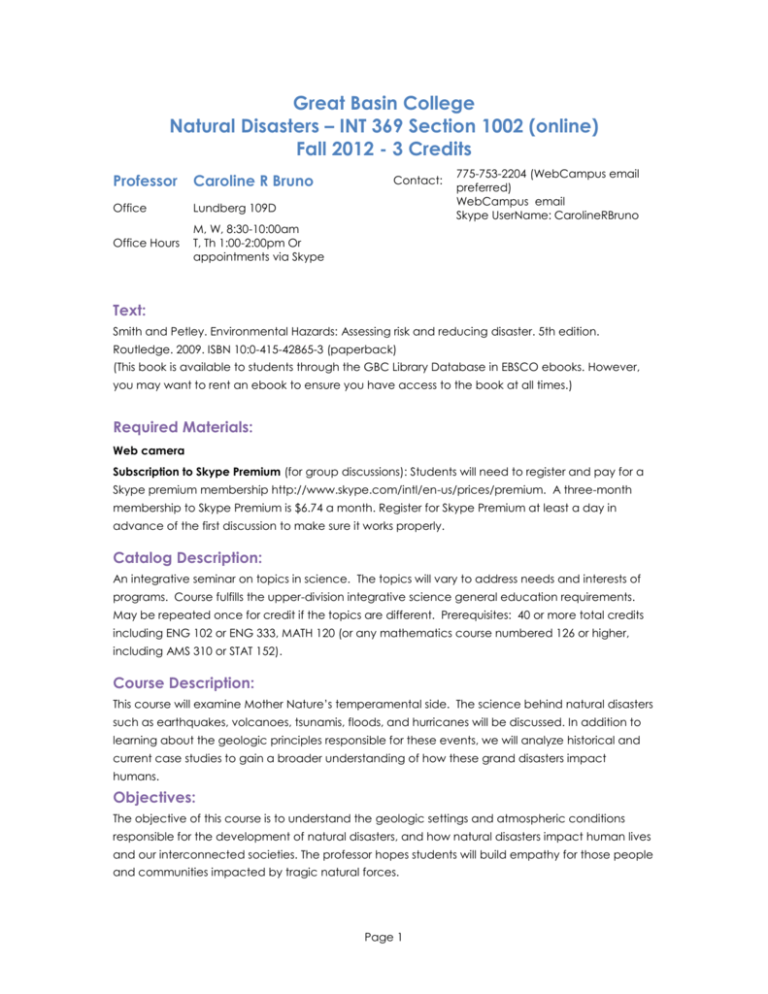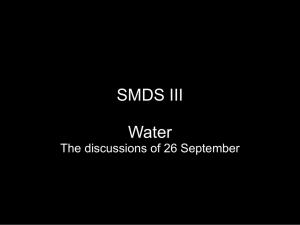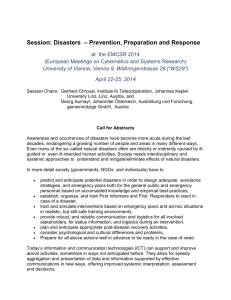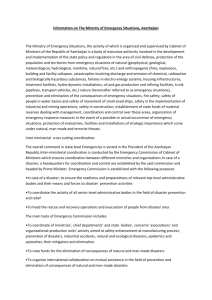INT 369 1002 - Great Basin College
advertisement

Great Basin College Natural Disasters – INT 369 Section 1002 (online) Fall 2012 - 3 Credits Professor Caroline R Bruno Office Lundberg 109D Office Hours M, W, 8:30-10:00am T, Th 1:00-2:00pm Or appointments via Skype Contact: 775-753-2204 (WebCampus email preferred) WebCampus email Skype UserName: CarolineRBruno Text: Smith and Petley. Environmental Hazards: Assessing risk and reducing disaster. 5th edition. Routledge. 2009. ISBN 10:0-415-42865-3 (paperback) (This book is available to students through the GBC Library Database in EBSCO ebooks. However, you may want to rent an ebook to ensure you have access to the book at all times.) Required Materials: Web camera Subscription to Skype Premium (for group discussions): Students will need to register and pay for a Skype premium membership http://www.skype.com/intl/en-us/prices/premium. A three-month membership to Skype Premium is $6.74 a month. Register for Skype Premium at least a day in advance of the first discussion to make sure it works properly. Catalog Description: An integrative seminar on topics in science. The topics will vary to address needs and interests of programs. Course fulfills the upper-division integrative science general education requirements. May be repeated once for credit if the topics are different. Prerequisites: 40 or more total credits including ENG 102 or ENG 333, MATH 120 (or any mathematics course numbered 126 or higher, including AMS 310 or STAT 152). Course Description: This course will examine Mother Nature’s temperamental side. The science behind natural disasters such as earthquakes, volcanoes, tsunamis, floods, and hurricanes will be discussed. In addition to learning about the geologic principles responsible for these events, we will analyze historical and current case studies to gain a broader understanding of how these grand disasters impact humans. Objectives: The objective of this course is to understand the geologic settings and atmospheric conditions responsible for the development of natural disasters, and how natural disasters impact human lives and our interconnected societies. The professor hopes students will build empathy for those people and communities impacted by tragic natural forces. Page 1 Method of Instruction: This is a fast-paced, rigorous online course. Students are responsible for checking WebCampus frequently to participate in discussions, obtain reading material, respond to emails, and complete assessments. Each topic in the course is associated with a learning module on WebCampus. In addition to the reading material shown on the course schedule, a plethora of online materials – such as newspaper articles, videos, photos, and animations are included in each learning module. The professor highly recommends reviewing these materials to gain a broad understanding of the topic or case study. Learner Outcomes and Measurement: The following table presents the expected learner outcomes for INT 369. Learner outcomes will be measured each time the class is taught as shown in the table below. Results from the assessments will be analyzed. Instruction in future semesters will be altered based on the analysis. Learner Outcomes Measurement/Assessment 1. Identify and explain the geologic settings Quizzes 1-4, 6-10 responsible for various types of natural disasters. Topic Presentation Final Exam 2. Identify the conditions responsible for the Quiz 5 formation of severe atmospheric disturbances. Topic Presentation Final Exam 3. Describe how communities can prepare for, Discussion Posts 1-4 predict, and assess risk for natural disasters. Final Exam 4. Describe how communities can respond to Discussion Posts 1-4 natural disasters. Final Exam 5. Describe how natural disasters impact humans Writing Assignments 1-4 on local, regional, and global scales. Term Paper Final Exam Evaluation: Quizzes: Students will complete quizzes associated with each topic. Generally, quizzes will focus on foundational material about the geologic or atmospheric processes behind each natural disaster discussed. They will be available on Tuesdays through Sundays. Quiz availability will not be extended under any circumstances. Take quizzes from a computer with a speedy and reliable internet connection. Immediately contact the GBC Helpdesk if technical problems arise. Skype Discussions: Students will meet with assigned discussion groups four times a semester to discuss current events and lecture material. Students are responsible for scheduling discussion times in advance of the due date and reporting the discussion time to the professor. Discussions must last at least 45 minutes. The discussion topics will focus on Learner Outcomes 3 and 4. Page 2 Following the Skype Discussions, each student will post a substantial 300-word response to discussion topics and thoughtfully respond to two fellow student posts. Responses MUST incorporate information from the required reading material. Writing Assignments: Students will submit four short writing assignments. Writing assignment topics based on Learner Outcome 5 will be posted at least two weeks prior to the due date. Responses MUST incorporate information from the required reading material. Presentations: To help develop presentation and ‘public’ speaking skills, students will be responsible for the following assignments: Video introduction - Students will introduce themselves in a 2-3 minute video. Topic Presentation -- Students will each prepare and record a 10 - 15 minute presentation that introduces topics regarding natural disasters. The focus of the presentation will discuss either 1. The geologic setting responsible for the natural disaster selected, or 2. The conditions responsible for the formation of severe atmospheric disturbances for the natural disaster selected (Learner Objectives 1 or 2). Each student must submit a PowerPoint presentation or notes for other students to use as a study aid. The professor highly recommends submitting your project at least 4 days in advance of the due date to receive feedback before the presentation is released to the entire class. Students may use webcams to produce these projects. Instructions for the presentations will be available during the first week of the semester. Final Project: Students will select a specific natural disaster, such as ‘The Eruption of Krakatoa,’ and report on how each of the course’s Learner Outcomes relates to the chosen topic. The Final Project topic must be approved by the professor by Tuesday, September 25. Students will need to choose a topic that is different than the case studies presented in class. Students will be responsible for submitting several small, preparation assignments leading up to the Final Project. Short Comprehensive Final Exam: A multiple choice final will focus on the learner outcomes outlined above. Page 3 Grading: Grading will be based on the Chapter quizzes, four writing assignments and the final exam. All scores will be added together at the end of the semester, and the percentage of the total possible points will determine the grade. Extra credit opportunities are not available. Grades will be based on the following divisions: A 95-100% A- 90-94% B+ 87-89% B 84-86% B- 80-83% C+ 77-79% C 74-76% C- 70-73% D+ 67-69% D 64-66% D- 60-63% F <59% A student may receive a “W” grade only if withdrawal occurs before the end of the thirteenth week of the semester. To withdraw, the student must inform the instructor verbally or in writing why the withdrawal is taking place, and must formally withdraw through student services. Anyone who does not formally withdraw and does not complete the course will receive an ‘F’ grade. ‘I’ grades for ‘incomplete’ will be given only under the most extenuating circumstances, and only with the prior approval of the instructor. Attendance Policy: It is important to log into the class frequently to stay up to date with reading, assignments and quizzes. It is the student’s responsibility to complete assignments and assessments on time. Page 4 Hints for Success: In order to pass this course you MUST actively participate in your education and study! Keep up to date on reading. ASK questions if you are confused. Your professor wants to HELP you! Take quizzes from a reliable computer with reliable internet service. Additional Course Information: Technical problems with WebCampus need to be addressed to the GBC Helpdesk (753-2167). Extra credit opportunities are NOT available. All communication in this course must be polite, formal and respectful. Page 5 Student Conduct Policy: Students are expected to follow the Student Conduct Policy for students in the Nevada System of Higher Education (NSHE) outlined in the GBC Catalog. Students will specifically be held accountable for behaving in a civil and respectful manner toward other students and the professor in all communications. The college catalog states, “Messages, attitudes, or any other form of communication deemed to be outside the bounds of common decency/civility as judged by common standards of classroom behavior (determined, as they would be in a regular classroom, by the instructor) will not be tolerated”. Pay particular attention to those last four words. Any student who behaves rudely to another student or to the instructor will be dropped from the course immediately. Academic Honesty: Academic dishonesty, in any form, such as, cheating and plagiarism, will not be tolerated by the instructor AND Great Basin College. Academic dishonesty can result in failing the class, academic suspension, or expulsion. All tests, quizzes, laboratories, and other assignments must be the student’s OWN work. Plagiarism is presenting someone else’s word, ideas or data as one’s own. When a student submits work that includes the words, ideas, or data of others, the source of that information must be acknowledged through complete, accurate, and specific references; and if verbatim statements are included, through quotation marks as well. In academically honest writing or speaking, the students will acknowledge the source whenever: Another person’s actual words are quoted Another person’s idea, opinion or theory is used, even if it is completely paraphrased in the student’s own words Facts, statistics, or other illustrative materials are borrowed, unless the information is common knowledge Students with Disabilities: The college catalog states, “Great Basin College is committed to providing equal educational opportunities to qualified students with disabilities in accordance with state and federal laws and regulations, including the Americans with Disabilities Act of 1990 and Section 504 of the Rehabilitation Act of 1973. A qualified student must furnish current verification of disability. The ADA Officer, located in Berg Hall, will assist qualified students with disabilities in securing the appropriate and reasonable accommodations, auxiliary aids, and services. For more information or further assistance, please call 775.753.2271”. Page 6 INT 369 Course Schedule for Fall 2012: Week 1 –Aug 27 Topic Reading Assignments/Assessments The Nature of WebCampus Resources Introductory Video Due Hazards 1 Smith and Petley Ch 1 and 3 SIGN UP FOR TOPIC PRESENTATIONS!! 2 – Sept 3 3 – Sept 10 The Nature of WebCampus Resources Hazards 2 Smith and Petley Ch 4 and 5 Discussion Post #1 Earthquakes: WebCampus Resources (No official assignment due, Overview Smith and Petley Ch 6 although you should be researching Final Project Topics) Earthquakes: 4 – Sept 17 WebCampus Resources Writing Assignment #1 WebCampus Resources Final Project Topic due Volcanoes: Smith and Petley Ch 7 Discussion Post #2 Overview WebCampus Resources Volcanoes: Case (Benediktsson, Lund and studies – Huijbens) Eyjafjallajökull, (Budd, Griggs and Howarth) Case studies – Haiti, San Francisco Tsunami: Case 5 – Sept 24 Studies – Japan, Indonesia 6 – Oct 1 7 – Oct 8 Update on Final Project Krakatoa 8 – Oct 15 Severe Storms: 10 – Oct 29 11 - Nov 5 12 - Nov 12 13 – Nov 19 Writing Assignment #2 WebCampus Resources Discussion Post #3 Overview Severe Storms: 9 – Oct 22 Smith and Petley Ch 9 Case Studies -- List of Resources for Final Katrina Project Floods: Overview Smith and Petley Ch 11 Writing Assignment #3 WebCampus Resources Floods: Case WebCampus Resources Discussion Post #4 WebCampus Resources Course Drop Deadline Studies Sinkholes: Overview and Rough Draft on Final Project Case Studies Due Mass Movements: Smith and Petley Ch 8 Writing Assignment #4 (Fleming, Varnes and Schuster) Final Project WebCampus Resources Open discussion! Overview 14 – Nov 26 15-Dec 3 16-Dec 10 Mass Movements: Case studies Asteroid Impact! BAM! Finals Week Final Exam Page 7 General Education Objectives and INT 369 General Education Objectives Learner Outcomes (as identified Measurement above) 1. Communication Skills – Strong 1. Identify and explain the Quizzes 1-10 This seminar requires substantial geologic settings responsible for Introductory Video written communication, as well as various types of natural disasters. Topic Presentation a moderate amount of online 2. Identify the conditions Final Exam discussion via Skype video responsible for the formation of conferencing. severe atmospheric disturbances. 2. Critical Thinking – Strong 3. Describe how communities Discussion Posts 1-4 Independent thought is can prepare for and predict Final Exam encouraged throughout the natural disasters. semester. Students will analyze 5. Describe how natural disasters quantitative and qualitative data impact humans on local, about natural disasters. regional, and global scales. 3. Personal and Cultural 3. Describe how communities Discussion Posts 1-4 Awareness – Strong can prepare for and predict Writing Assignments 1-4 Students will learn how societies natural disasters. Final Project are impacted by natural disasters. 4. Describe how communities Final Exam can respond to natural disasters. 5. Describe how natural disasters impact humans on local, regional, and global scales. 4. Personal Wellness – Strong Discussion Posts 1-4 Students will learn how to prepare 3. Describe how communities for and respond to natural can prepare for and predict disasters. natural disasters. Final Exam 4. Describe how communities can respond to natural disasters. 5. Technological Understanding – 5. Describe how natural disasters Writing Assignments 1-4 Moderate impact humans on local, Final Project Students will use Canvas to regional, and global scales. Final Exam retrieve information about course content. They will use online databases for research projects. Page 8 Works Cited Abbott, P. (2012). Natural Disasters (8th ed.). New York, NY: McGraw Hill. Benediktsson, K., Lund, K. A., & Huijbens, E. (2001). Inspired by Eruptions? Eyjafjallajokull and Icelandic Tourism. Mobilities, 6(1), 77-84. Budd, L., Griggs, S., Howarth, D., & Ison, S. (2011). A Fiasco of Volcanic Proportions? Eyjafjallajokull and the Closure of European Airspace. Mobilities, 6(1), 31-40. Cohen, E. (2009). Death in paradise: tourist fatalities in the tsunami disaster in Thailand. Current Issues in Tourism, 183-199. Farmer, P. (2011). Haiti after the earthquake. New York, NY: Public Affairs. Fleming, R., Varnes, D., & Schuster, R. (2007, November). Landslide Hazards and Their Reduction. Journal of the American Planning Association, 45(4), 428-439. Hess, D. (2011). McKnight's Physical Geography: A Landscape Appreciation (10th ed.). Upper Saddle River, NJ: Prentice Hall. Hyndman, D., & Hyndman, D. (2011). Natural Hazards and Disasters (3rd ed.). Belmont, CA: Brooks/Cole. Karan, P. P., & Subbiah, S. P. (2011). The Indian Ocean Tsunami: The Global Response to a Natural Disaster. Lexington, KY: The University Press of Kentucky. Plummer, C. C., Carlson, D. H., & Hammersley, L. (2013). Physical Geology. New York: McGraw Hill. Smith, K., & Petley, D. N. (2009). Environmental Hazards: Assessing risk and reducing disaster (5th ed.). New York: Routledge. The International Bank for Reconstruction and Development. (2010). Natural Hazards, UnNatural Disasters. The Economics of Effective Prevention. Washington, D.C: The World Bank. Winchester, S. (2005). The Crack in the Edge of the World. New York: Harper. Page 9






